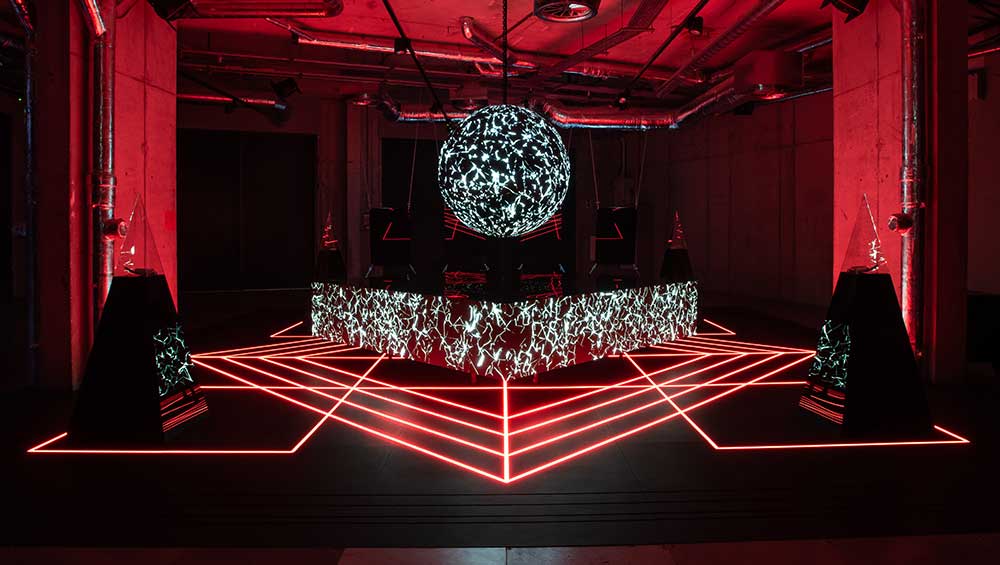
Zach Blas, Cultus, 2023. Installation view, arebyte, London. Photo: Max Colson.
by BRONAĊ FERRAN
As you approach London City Island, walking over the recently built footbridge from Canning Town station, a cluster of differently coloured buildings rise silhouetted against the grey London skyline. Among the high-rise residential buildings, small-scale retail outlets, gyms and cafes that form this urban property development, built over the last decade on a peninsula formed by the last loop of the River Lea before it enters the Thames, is the arebyte gallery and artists’ studio complex.
Arebyte is a charitable organisation specialising in digital art. It opened in 2013 in Hackney Wick, east London, and moved to London City Island in 2017. It has recently received confirmation of guaranteed three-year funding from Arts Council England for its programme of exhibitions in physical and online spaces, combined with educational activities that connect it to partners locally and across London.
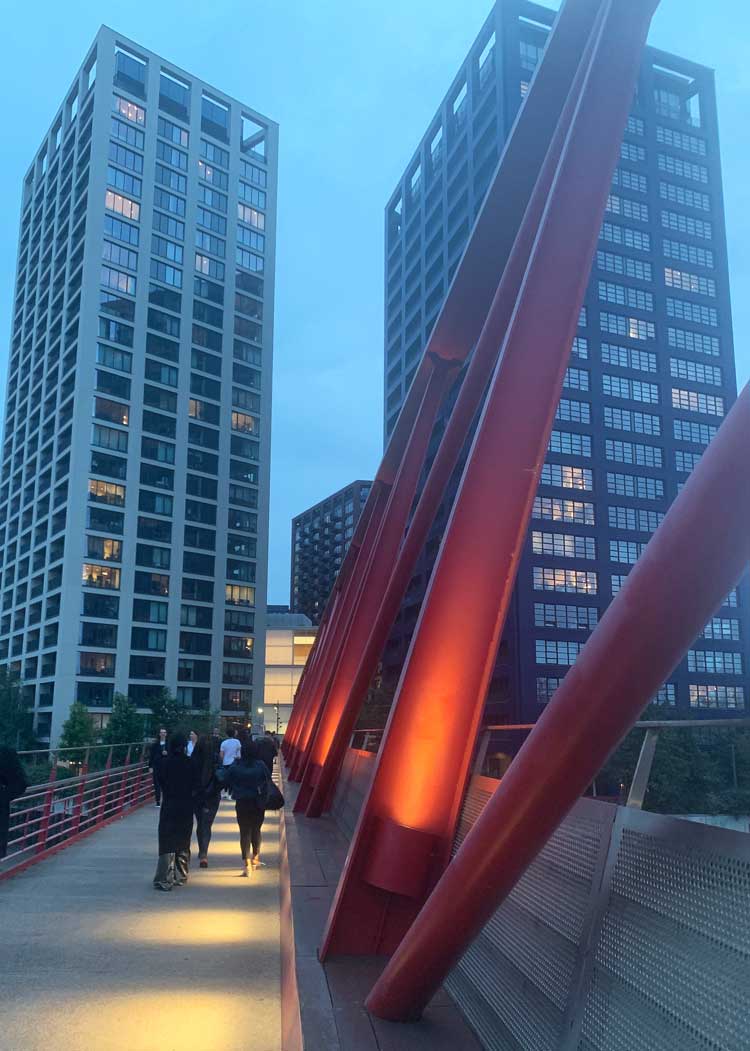
Pedestrian bridge to London City Island. Photo: Bronac Ferran.
Also running a suite of affordable artists’ studios and workspaces for creative businesses, it is the archetype of a mixed-economy cultural organisation, drawing on public and private funding. It fits seamlessly into the vision that the commercial property developer Ballymore has for London City Island as a new cultural quarter for the capital, with purpose-built rehearsal studios for English National Ballet a major anchor of this narrative.
The residential buildings throughout the development, as well as the building housing the gallery, with its dark-glass frontage, feature bricks that were chosen by the architects to echo aspects of the industrial history of this location, surrounded as it is by water on three sides. The buildings are also characterised by being primarily parallelograms in structure rather than rectangles, a motif that finds a certain mirroring in the exhibition design of Cultus, an installation by the media artist and theorist Zach Blas.

arebyte, London. Photo: Bronac Ferran.
Developed as a co-production with Secession in Vienna, Cultus is a haunting and evocative exhibition that deserves to be seen more widely, speaking, as it does, to multiple preoccupations of the present. Blas has spoken of the importance of his early study of film to his artistic approach. Indeed, this exhibition has a cinematic and virtual quality that draws you into its incantatory and invocatory soundscape, while playing seductively with the visual sensorium, and stimulating visitors to sit in immersive contemplation as if encountering a mystical ceremony. Flashes of clarity coalesce with enduring moments of obscuration: are we meant to be able to read the textual components or are they designed to elide our capacity for elucidation? Do we leave the gallery subscribing to this new, not yet fully comprehended Cultus?
Blas duly conjures up a series of Silicon Valley “gods” and seeks to reincarnate the Elizabethan magician John Dee’s “Holy Table” and prophetic sphere, along with a subtext of the queer and heretical conveyed through a blended human and machine- language soundtrack. The exhibition concept fits closely with the curatorial theme of The Body, the Mind and the Soul, selected by the arebyte team as its focus from 2023 to 2025. I discussed this with Nimrod Vardi, the organisation’s founder and creative director, and Claudel Goy, its managing director.
Bronaċ Ferran: How did you end up in this extraordinary location?
Arebyte: We started in 2013 with a 500 sq ft [46.5 sq metre] gallery on the first floor of an artists’ studio building in Hackney Wick, east London. In 2016, we opened another site, in Clerkenwell, secured in partnership with Outset’s Studiomakers initiative, which was developed as a response to loss of studio spaces in the city with the aim of securing long-term spaces for artists. We stayed there for 18 months, creating Arebyte Laser, which focused on young artists and is now the basis of Hotel Generation, our young artist development programme. Outset also introduced us to Ballymore, the developers and landlords here at London City Island. So, in 2017, we took on an initial five-year lease, which has now been extended, of this building – which is 700 sq metres in total – where we have a gallery as well as co-working spaces and artists’ studios.
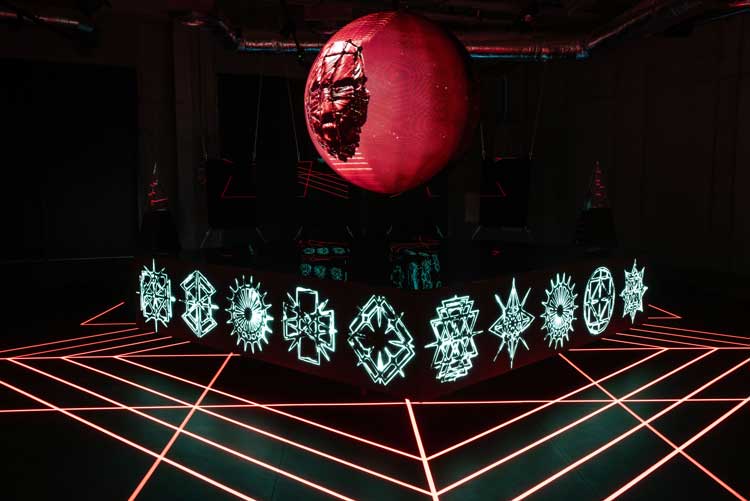
Zach Blas, Cultus, 2023. Installation view, arebyte, London. Photo: Max Colson.
BF: Can you say more about your artistic direction?
Arebyte: We have become known for taking a strong curatorial approach. We develop a theme that we wish to advance and then think of artists who might be suitable. Each year, we do one major solo show and a group show, as well as a solo show online and a group show online. We try to work with artists the whole way through, from those who are emerging to those who are better known and established. We are particularly good at understanding the concept and assembling the project and shaping it into the space. In fact, every time the gallery looks very different; we really excel in that, and the responses have been very positive. Each time, we appear to top the previous production, which is very exciting for us. The response to the project with Zach [Blas] has been really positive. This exhibition came out of knowing him and his work for years and having wanted to do something with him for a while.
When we first moved here, the curatorial themes were quite political. For example, we worked on the concept of islands in a period that coincided with Brexit. After the end of Covid and all that it involved, we decided on the theme of The Body, the Mind and the Soul for 2023 to 2025, which we thought would restore a stronger sense of what it means to be human, going back to the self, the mind, the body and maybe having a soul, and to see how this expanding field might connect to the digital. Zach’s work is very much like this. The exhibition creates a sense of ritual, like a ceremonial act that you can sense happening around you, using the walls and the floor and the ceiling. So that’s how we curate.
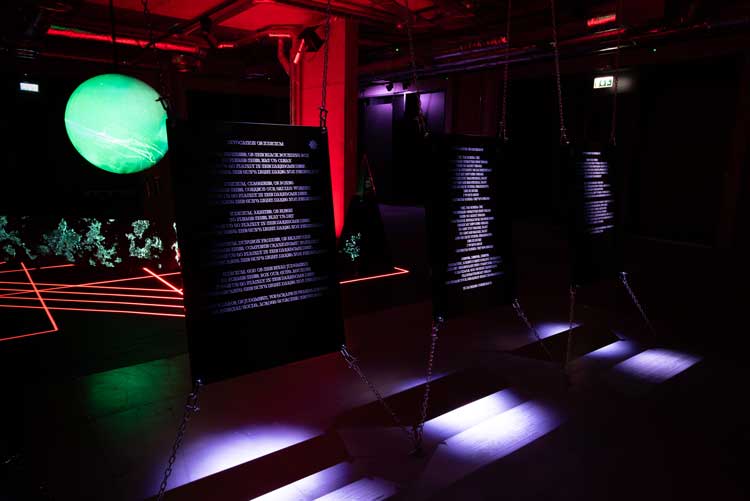
Zach Blas, Cultus, 2023. Installation view, arebyte, London. Photo: Max Colson.
Sometimes when we work with someone, it can help to bring what they are doing to broader attention. That, in turn, helps to establish the sector. When we were working with Danielle Brathwaite-Shirley, her project She Keeps Me Damn Alive made the cover of Frieze. It was also selected by Frieze as among the top 10 exhibitions in the UK and Ireland in 2022.
We like to offer a very critical approach towards new technologies and give our audience another way to look at and explore the role of technologies in our lives. Also, in 2022, we worked with the avatar artist LaTurbo Avedon on an online commission called Club Zero. It followed the emergence of three new avatars presented as non-fungible people (NFPs), which expanded on the role of non-fungible tokens (NFTs) and blockchain systems within art and how the future might look for technology of this kind.
In addition to our programme of exhibitions, we have a lot of training initiatives around creative media technology. There is more and more demand for digital content creation, so we run workshops for all ages and skill levels, from children and young people to artists looking into introductory or more advanced sessions on coding, 3D modelling, sound editing, artificial intelligence (AI) and virtual world-making.
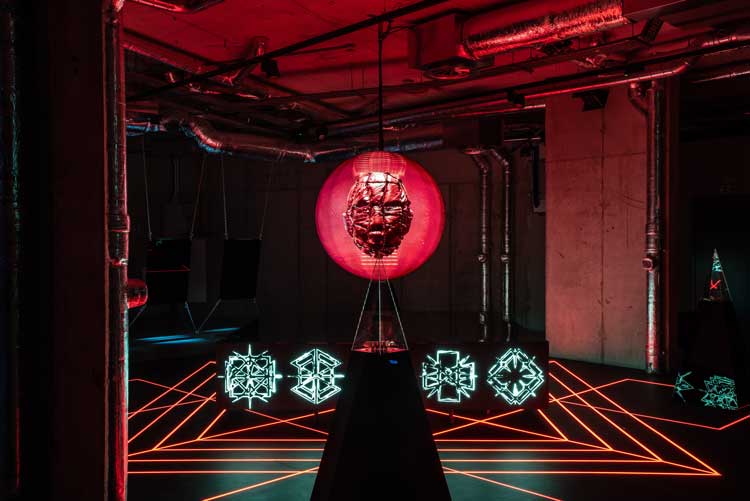
Zach Blas, Cultus, 2023. Installation view, arebyte, London. Photo: Max Colson.
Another strand of our educational programme is that we work with students aged 16 to 17 who are attending the game design course at East London Arts and Music academy. We run a course for them, bringing in artists to lead a module; the idea behind this is to show younger games designers or practitioners that there are other ways, other career paths than just the more obvious routes. So, they might also become indie designers or artists. It is important to give them the artistic and conceptual point of view. This year, the artist involved is David Blandy. We also have links with universities where students already know they want to work professionally in the arts, so this is their career path. We allow some of them to spend time at arebyte, working alongside the curatorial or production or marketing team, for instance.
We have also been developing a series of relationships with various research organisations and curatorial and digital art related courses. Every year, we work with a different university. This year it is with University College London; last year, it was with Central Saint Martins, which was the first year we worked with a curating course. Before that, it was Goldsmiths, then the Royal College of Art, the University of Westminster and Middlesex University.
BF: Do people come here?
Arebyte: People come. It’s an up-and-coming area and being here early has given us a chance to grow along with that. When we first moved here, the site was very much under development and not yet on the cultural map. It was a bit like: “Where are we and what are we doing here?” But we had 10,000 visitors in our first year and the numbers have continued to increase since. The Jubilee line running to Canning Town and the Elizabeth Line connecting to the DLR make a big difference. The plan of Ballymore to turn this into a cultural hub is working. There is the English National Ballet onsite and we’re just down the road from Trinity Buoy Wharf with Jem Finer’s fantastic Longplayer, a 1,000-year sound installation and various kinetic sculptures there. We’re also really close to the entrance to the Royal Docks, one of the leading development sites in London.
BF: I have heard you have some exciting plans for future growth. What are these?
Arebyte: We are working on setting up London’s first digital art centre. We want to bring digital artists and creative tech professionals together under one roof, to create a whole new ecosystem. We will have gallery spaces for exhibitions and performances, and affordable creative workspaces for all kinds of digital practitioners: new media artists, technologists, coders, app developers, 3D animators, CGI designers, video game and visual effects studios. We will also have digital production facilities for extended reality content and a dedicated educational room for skills development. It’s a very ambitious capital project that means scaling up massively. But we feel we are the right organisation to deliver this.
We’re working on the capital fundraising campaign. We’re looking at a mix of private and public funding to get the project off the ground. We hope to be able to open in the next two years in a 25,000 sq foot [2,300 sq metre] building two minutes away from where we are now, thanks to a partnership with Ballymore.
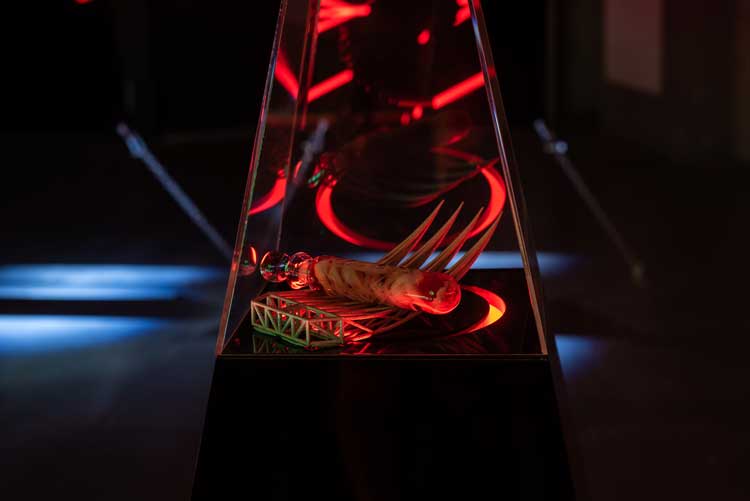
Zach Blas, Cultus, 2023. Installation view, arebyte, London. Photo: Max Colson.
In terms of this future trajectory, we’re hoping it might allow us to consolidate some of our academic research partnerships in ways that take on board the fact that many of the artists we work with, such as Zach, do a lot of deep research before the exhibition concept is realised. You can certainly see that with this current exhibition, which is multilayered and underpinned by a lot of theory and yet it works on a highly sensory and embodied level, transforming what might have been research at the beginning into something you can walk through and experience in an immersive sense. We’re very keen as curators to explore those boundaries, of being inside and outside the work at different levels. It is all very well working on screens, but we’re interested in a sense of physicality and of making the digital somehow real by being present within the territory of the gallery.
Digital art has received a lot of focus over the last few years, from the experience economy and NFTs through to new technologies, such as augmented reality, virtual reality and, more recently, AI-generated art. And though it may have seemed to some people that all this suddenly came out of nowhere, in fact many exciting and incredible people have been working in this field for decades. We think you can’t really understand what is happening now without understanding what happened then. While NFTs have a place in that timeline, it is also important to see how we got here. Also, here in London, we are seeing more and more immersive digital arts venues, but they are mainly from the private sector. We see a need for a public art institution to provide context for the genre and support the development of early career artists. In the new digital art centre, we will also have a permanent display highlighting the UK history of digital art with a display of rotating collections in the field.
We don’t intend to show only a chronological timeline of individuals working in the field or events such as seminal exhibitions that took place, but rather to explore the history of how digital arts impacted other industries and to open up the conversation to wider and more diverse audiences and collaborators. We would then invite artists and researchers in residence to respond to this challenge.
We are set on drawing together all these components. We think the idea of a dedicated digital art space is something that needs to happen. For us, it is the whole ecosystem around digital art and education around that, rather than just a commercial venture. We want to explore what exactly it means to rethink the history of digital arts in the UK and worldwide. If it is not us, then it will be someone else. The question is: “What will it look like?”
• Cultus by Zach Blas is at arebyte, London, until 17 February 2024.